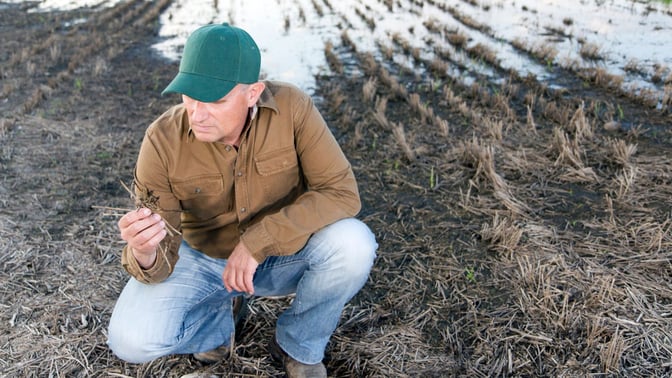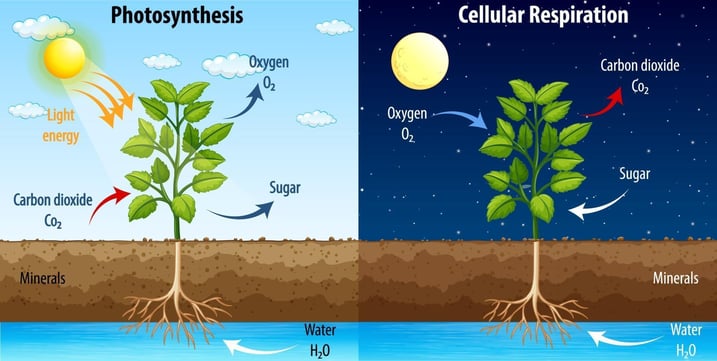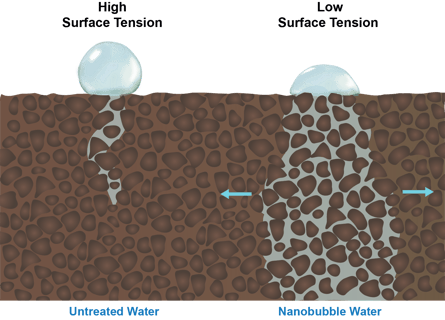What is Root Hypoxia and How Does it Impact Orchards?
Root hypoxia is a condition that occurs when the root system of a plant experiences inadequate oxygen levels. Next to pests and disease, it’s the number one enemy of fruit and nut tree growers around the globe.
This lack of oxygen can be due to various factors, including waterlogged or compacted soil, which restricts the movement of air into the root zone. When root hypoxia occurs, it can have detrimental effects on the overall health and growth of the plant. Oxygen is essential for root respiration and nutrient uptake, so an oxygen deficiency can hinder a fruit tree or plant's ability to absorb water and essential nutrients, leading to stunted growth, wilting, and other symptoms of stress. Managing and preventing root hypoxia is crucial for maintaining the well-being of orchards and other crops.
Waterlogging is Increasing with Extreme Weather Events
The direct causes of root hypoxia – soil waterlogging and/or flooding – are on the rise because extreme weather events such as intense rainstorms and hurricanes are becoming much more common. Poor soil health and structure that lead to soil compaction also exacerbate the waterlogging of soil.
The incidence of root hypoxia, also known as oxygen deficiency stress, is increasing in areas where fruit trees and crops already experience hypoxia but also, according to a team of scientists at the University of Florida, in areas where it’s never been seen.

In their 2023 paper in Environmental and Experimental Botany, this team stresses that waterlogged soil is “one of the most important limitations to agricultural crop production.”
“The yield loss resulting from root zone hypoxia may vary between 15% and 80%, depending on the species, soil type and duration of the stress. In the USA alone, 16% of soils are affected by waterlogging, and among abiotic stresses, economic losses to crop production from waterlogging are estimated to be the second only to losses from drought.”
NEGATIVE EFFECTS OF ROOT HYPOXIA IN TREE FARMING
There are many ways root hypoxia negatively impacts overall tree and root growth, health and development.
As these scientists in Florida explain, oxygen deficiency stress results in decreased root cellular respiration, hormone biosynthesis, carbohydrate mobilization, generation of reactive oxygen species (ROS) and much more:
“At the whole-plant level, hypoxia causes reductions in photosynthesis, stomatal conductance and leaf water potential. These physiological responses can change energy consumption, cellular metabolism and gene expression that subsequently affect plant growth and development.”
In other words, when a plant, like a fruit tree, doesn't get enough oxygen in the root zone, it affects the plant's overall health. It reduces the plant's ability to make food through photosynthesis, causes problems with how it breathes through tiny openings in its leaves, and makes it struggle to get enough water. All these issues can slow down the plant's growth and development, and even change how its cells work. So, oxygen is super important for a plant to grow and stay healthy.
SOIL MECHANICS THAT IMPACT ROOT HYPOXIA: COMPACTION AND WATERLOGGING
Dr. Fariborz Habibi and his colleagues from the University of Florida explain that flooding (water that remains on the soil surface) and waterlogging (saturated soil) lead to oxygen deficiency in the soil because water entering the soil displaces all the oxygen-rich air that was present in soil pores.
They note that “low soil oxygen due to excess soil water is one of the major abiotic stresses that has dramatic effects on fruit tree productivity.”
This is because “oxygen is one of the most essential molecules for cellular metabolic activities, growth and development of plant cells. […] Fruit trees need a suitable supply of oxygen in the soil for growth and development. Hypoxia leads to a deprivation of oxygen in the rhizosphere, which can inhibit root respiration in fruit trees. […] Generally, hypoxia restricts aerobic cellular respiration when the soil oxygen concentration is as low as 1 to 5 %.”
Here is a quick summary from Habibi and his colleagues of the specifics of how limited oxygen availability negatively affects root structure and individual root cells:
- It causes disturbance and dysfunction of cellular metabolism, eventually leading to observable tissue damage.
- Anaerobic conditions in the soil also affect soil pH and redox potential, the respiration of soil microorganisms, and subsequently, results in the accumulation of potentially toxic metabolites.
- This anaerobic root respiration leads to phytotoxicity in fruit trees. Root injury can result from the presence of acetaldehyde, heavy metals and other “destructive compounds.”
- Root zone hypoxia inhibits mineral uptake and transport because oxygen deficiency in root tissues blocks mitochondrial cellular respiration. It also inhibits root hair development and root elongation and depletes ATP reserves.
- In addition, lack of oxygen induces oxidative phosphorylation to fermentation within the roots, subsequently limiting ATP formation in the first place.
ATP and Oxygen - Keys to Tree Growth
ATP (adenosine triphosphate) is cell-level energy that drives the process of cellular respiration. Oxygen is also required for cellular respiration. In fact, it’s a limiting factor.
 Figure 2: Image from Vecteezy.com
Figure 2: Image from Vecteezy.com
The more oxygen the root cell has, the higher its rate of respiration. Root respiration powers the absorption of water and nutrients. The more water and nutrients absorbed, the higher the rate of plant/tree growth and fruit yield.
Maximizing Water Oxygenation with Nanobubble Technology on Tree Farms
Ongoing irrigation with oxygen nanobubble-enriched water results in the most robust root systems and improved levels of fruit tree health.
But, even more importantly, nanobubble-enriched irrigation water also increases the penetration rate of water on the soil surface and the infiltration rate of water into the soil profile by reducing the surface tension of water.
Orchard fruit and nut tree farms and nurseries around the world have implemented Moleaer’s nanobubble technology.
Oxygen nanobubbles are a cost-effective, proven, sustainable way to achieve increased and more stable levels of dissolved oxygen in irrigation water as well as produce a myriad of benefits from nano-sized bubbles. Moleaer’s proprietary technology has an oxygen transfer rate of over 85%, more than double that achievable with the higher cost aeration units.
As their name suggests, nanobubbles are tiny bubbles under 200 nanometers in diameter. They hover and move within liquids, participating in and instigating physical, biological and chemical changes.
For instance, nanobubbles enhance oxidative effects, when they encounter contaminants in water, reducing waterborne pathogens without chemicals. They also have a hard surface that allows them to naturally abrade biofilm from irrigation systems, helping to reduce emitter clogging. This improves water quality, protects plant health and reduces the use of disinfection chemicals.
GETTING RID OF EXCESS WATER FOR LESS WATERLOGGING IN TREE FARMING
Nanobubbles possess high internal pressure and a hard surface. On bursting, they break the surface tension of water, boosting its infiltration capacity. Water with reduced surface tension has better water penetration and distribution in hydrophobic soils:

In addition, water with reduced surface tension better penetrates compacted soil, preventing flooding and waterlogging. Nanobubble-treated irrigation water also increases soil flocculation (aggregation of clay particles), reducing soil compaction.
In addition, nanobubbles carry a positive charge and as they move continuously through water, they reduce the cluster sizes of water molecules. This also improves the infiltration of water on the surface of the soil and within the soil.
YIELD IMPROVEMENTS AND MORE
For more on how Moleaer technology decreases root hypoxia from waterlogged and flooded soils, please see this post about avocado production in Chile and Europe.
The avocado tree has a root system close to the soil surface, requiring irrigation to fight the intermittent dry periods and drought. However, the high-clay soils that are common in avocado-growing regions retain water for longer periods of time than sandier soil, increasing the risk of waterlogging. (And these soils are also the most prone to compaction).
Also, see the case study from Kapicua about an avocado tree farm in Chile, where they increased their DO by almost 200% and experienced many other benefits from the use of Moleaer nanobubble generators.
Embracing the Future: Protecting Fruit Trees with Moleaer's Nanobubble Innovation
In conclusion, the world of fruit tree farming faces a hidden adversary in the form of root hypoxia, a condition caused by insufficient oxygen in the root system. Oxygen plays a critical role in plant health and the detrimental effects of root hypoxia on growth and development. The rise in extreme weather events and poor soil health compounds this problem, making it a significant challenge for fruit tree growers worldwide.
The application of nanobubble technology, such as Moleaer's innovative solutions, offers a cost-effective and sustainable means to combat root hypoxia and promote robust root systems, ultimately leading to increased fruit tree health and better yields. Real-world case studies, like avocado tree farming in Chile and Europe, demonstrate the tangible benefits of this technology in tackling the root hypoxia challenge. As we continue to face changing environmental conditions, innovative solutions like nanobubble technology provide hope for a healthier and more productive future for fruit tree farming.


